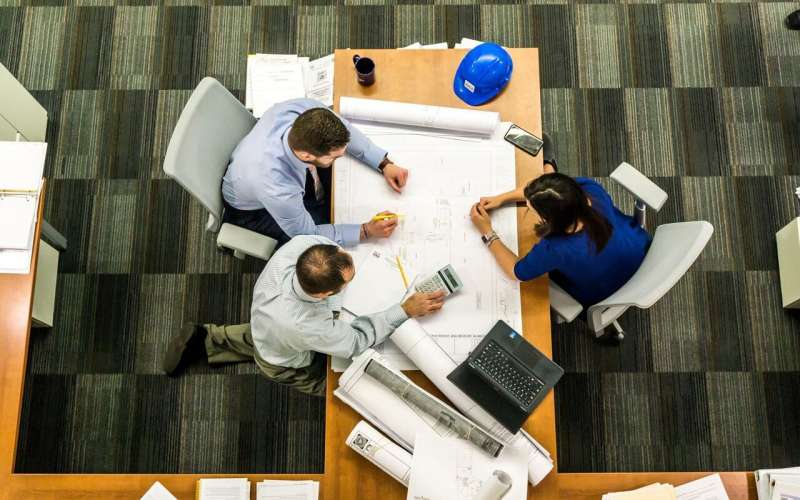Better use of office daylighting can improve people's well-being

A Ph.D. student at EPFL studied the use of automated control systems for blinds and electric lighting to regulate the amount of daylight in an office, and found that such systems can cut a building's energy demand and stimulate occupants' circadian rhythms, improving their health and well-being.
"We spend 90 percent of our time indoors, in buildings where we use way too much energy," says Marta Benedetti, a recent EPFL Ph.D. graduate in energy systems engineering. This is a problem in office buildings in particular. "When we're working, we're unlikely to get up and adjust the blinds or dim the lights in response to changes in daylight over the course of the day."
Some office buildings are equipped with computer-controlled blinds and electric lighting systems that are designed to automatically provide the optimal amount of light at each time of day. These systems adapt to natural variations in sunlight by dimming artificial light sources when they aren't needed, for example, in order to take full advantage of the daylight available. But until now, engineers weren't clear on how much energy these systems really saved and what tangible benefits they brought to occupants' health and well-being. These are the questions Benedetti set out to answer in her Ph.D. thesis, carried out at EPFL's Solar Energy and Building Physics Laboratory (LESO-PB) within the School of Architecture, Civil and Environmental Engineering (ENAC).
Watches, sensors and glasses
As part of her study, which lasted over a year, she ran an experiment with 34 volunteers in LESO-PB's testing building. The participants each spent one week working in an office equipped with an automated blind-control and artificial lighting system, and one week working in a standard office. In both types of offices, the participants were free to adjust the blinds and electric lighting themselves at any time. The goal of the experiment was to measure the effects that the different types of daylight exposure had on the participants' bodily systems. "We asked the volunteers to wear a smartwatch during all four weeks of the experiment to record their number of sleeping and waking hours," says Benedetti. "And during the in-office weeks, volunteers also wore skin temperature sensors as well as glasses with light sensors so we could record how much light their eyes were exposed to."
In addition, saliva samples were taken regularly to measure the concentrations of melatonin, also known as the darkness hormone, and cortisol, a hormone released when the body is under stress. Benedetti learned how to collect and analyze the samples from her thesis co-supervisor, a chronobiologist who introduced her to concepts in this field. "I read many studies on how daylight affects the human body, especially the secretion of hormones that regulate our sleep patterns and moods," says Benedetti. "This knowledge can be used to help prevent serious diseases like cancer."
Energy savings
To evaluate the impact in terms of energy efficiency, Benedetti installed meters to measure the amount of energy used for lighting and heating in each type of office over the course of a year. She found that the office equipped with the automated system consumed 9.6 percent less electricity than the regular office, alongside no reduction in the participants' visual comfort. Other bodily effects that Benedetti measured, such as sleep quality and cognitive performance, were comparable regardless of which office the participants worked in. Visual comfort was measured using a special kind of glare meter developed jointly by LESO-PB and the Swiss Center for Electronics and Microtechnology (CSEM), and was found to be in an acceptable range during all phases of the experiment.
When working in the office with the automated system, participants accumulated 50 minutes of daylight exposure earlier in the morning than when they worked in the standard office. Their melatonin concentration consequently peaked around 25 minutes earlier in the evening, better preparing their bodies for sleep. The difference in body temperature between their torso and limbs (the distal-proximal skin-temperature gradient) began to fall 19 minutes earlier in the morning, to prepare the body to wake up, and started to rise 20 minutes earlier in the evening, to prepare the body for sleep.
Helping with sleep disorders
"The volunteers were free to live their lives normally throughout the experiment—go out for lunch, work out, and so on—apart from wearing the sensors," says Benedetti. "This means the data collected during our study are more representative than those from previous ones, which were generally carried out in a more tightly controlled environment. We found that by changing the amount of daylight people are exposed to, we can influence their circadian rhythms. Automated systems like the one we tested could help people who suffer from sleep disorders, for example." It's worth pointing out that both offices used in the experiment already had a lot of daylight by design. That explains why there was little difference in some of the measured variables, according to Benedetti.
More information: Benedetti, Marta, Integrating non-visual effects of light in the automated daylight-responsive control of blinds and electric lighting, Infoscience (2021). DOI: 10.5075/epfl-thesis-8414


















